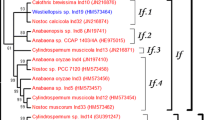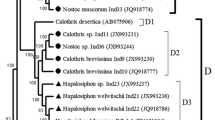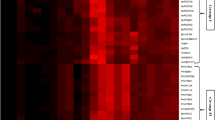Abstract
In order to assess phylogeny, population genetics, and approximation of future course of cyanobacterial evolution based on nifH gene sequences, 41 heterocystous cyanobacterial strains collected from all over India have been used in the present study. NifH gene sequence analysis data confirm that the heterocystous cyanobacteria are monophyletic while the stigonematales show polyphyletic origin with grave intermixing. Further, analysis of nifH gene sequence data using intricate mathematical extrapolations revealed that the nucleotide diversity and recombination frequency is much greater in Nostocales than the Stigonematales. Similarly, DNA divergence studies showed significant values of divergence with greater gene conversion tracts in the unbranched (Nostocales) than the branched (Stigonematales) strains. Our data strongly support the origin of true branching cyanobacterial strains from the unbranched strains.







Similar content being viewed by others
References
Castenholz RW (2001) Phylum BX. Cyanobacteria, oxygenic photosynthetic bacteria. In: Boone DR, Castenholz RW (eds) Bergey’s manual of systematic bacteriology, vol 1. Springer, New York, p 721
Desikachary TV (1959) Cyanophyta, part I and II. Indian council of agricultural research, New Delhi
Dopazo J (1994) Estimating errors and confidence intervals for branch lengths in phylogenetic trees by a bootstrap approach. J Mol Evol 38:300–304
Gugger M, Hoffmann L (2004) Polyphyly of the true branching cyanobacteria (Stigonematales). Int J Syst Evol Microbiol 54:349–357
Gugger M, Lyra C, Henrikson P, Coute A, Humbert JF, Sihvonen K (2002) Phylogenetic comparison of the cyanobacterial genera Anabaena and Aphanizomenon. Int J Syst Evol Microbiol 52:1867–1880
Gugger M, Molica R, Berre BL, Dufour P, Bernard C, Humbert JF (2005) Genetic diversity of Cylindrospermopsis Strains (Cyanobacteria) isolated from four continents. Appl Environ Microbiol 71:1097–1100
Henson BJ, Watson LE, Barnum SR (2002) Molecular differentiation of the heterocystous cyanobacteria, Nostoc and Anabaena, based on complete NifD sequences. Curr Microbiol 45:161–164
Henson BJ, Hesselbrock SM, Watson LE, Barnum SR (2004) Molecular phylogeny of the heterocystous cyanobacteria (subsections IV and V) based on nifD. Int J Syst Evol Microbiol 54:493–497
Iteman I, Rippka R, Tandeau de Marsac N, Herdman M (2002) rDNA analyses of planktonic heterocystous cyanobacteria, including members of the genera Anabaenopsis and Cyanospira. Microbiol 148:481–496
Jukes TH, Cantor CR (1969) Evolution of protein molecules. In: Munro HN (ed) Mammalian protein metabolism. Academic, New York, pp 21–132
Komárek J, Anagnostidis K (1989) Modern approach to the classification system of cyanophytes 4 Nostocales. Arch Hydrobiol Suppl 82:247–345
Lammers P, Haselkorn R (1984) Sequence of the nifD gene coding for the α subunit from the cyanobacterium Anabaena. Cell 44:905–911
Librado P, Rozas J (2009) DnaSP v5: a software for comprehensive analysis of DNA polymorphism data. Bioinformatics 25:1451–1452
Mevarech M, Rice D, Haselkorn R (1980) Nucleotide sequence of a cyanobacterial nifH gene coding for nitrogenase reductase. Proc Natl Acad Sci USA 77:6476–6480
Mishra AK, Shukla E, Singh SS (2012) Phylogenetic comparison among the heterocystous cyanobacteria based on a polyphasic approach. Protoplasma. doi:10.1007/s00709-012-0375-9
Mollenhauer D (1988) Nostoc species in the field. Arch Hydrobiol Suppl 80(315):326
Neilan BA, Jacobs D, Goodman AE (1995) Genetic diversity and phylogeny of toxic cyanobacteria determined by DNA polymorphisms within the phycocyanin locus. Appl Environ Microbiol 61:875–3883
Postgate JR (1982) The fundamentals of nitrogen fixation. Cambridge University Press, Cambridge
Rajaniemi P, Hrouzek P, Kastovska K, Willame R, Rantala A, Hoffmann L, Komárek J, Sivonen K (2005) Phylogenetic and morphological evaluation of the genera Anabaena, Aphanizomenon, Trichormus and Nostoc (Nostocales, Cyanobacteria). Int J Syst Evol Microbiol 55:11–26
Rippka R (1988) Recognition and identification of cyanobacteria. Methods Enzymol 167:28–67
Rippka R, Herdman M (1992) Pasteur culture collection of cyanobacterial strains in axenic culture, catalogue and taxonomic handbook. Institut Pasteur, Paris
Rippka R, Deruelles J, Waterbury JB, Herdman M, Stanier RY (1979) Generic assignments, strain histories and properties of pure cultures of cyanobacteria. J Gen Microbiol 111:1–61
Rzhetsky A, Nei M (1992) A simple method for estimating and testing minimum evolution trees. Mol Biol Evol 9:945–967
Saitou N, Nei M (1987) The neighbour joining method—a new method for reconstructing phylogenetic tree. Mol Biol Evol 4:406–425
Sihvonen LM, Lyra C, Fewer DP, Rajaniemi-Wacklin P, Lehtimáki JM, Wahlsten M, Sivonen K (2007) Strains of the cyanobacterial genera Calothrix and Rivularia isolated from the Baltic Sea display cryptic diversity and are distantly related to Gloeotrichia and Tolypothrix. FEMS Microbiol Ecol 61:74–84
Stuken A, Rucker J, Endrulat T, Preussel K, Hemm M, Nixdorf B, Karsten U, Wiedner C (2006) Distribution of three alien cyanobacterial species (Nostocales) in northeast Germany Cylindrospermopsis raciborskii, Anabaena bergii and Aphanizomenon aphanizomenoides. Phycologia 45:696–703
Tamas I, Svircev Z, Andersson SGE (2000) Determinative value of a portion of the nifH sequence for the genera Nostoc and Anabaena (Cyanobacteria). Curr Microbiol 41:97–200
Tamura K, Peterson D, Peterson N, Stecher G, Nei M, Kumar S (2011) MEGA5: molecular evolutionary genetics analysis using maximum likelihood, evolutionary distance and maximum parsimony methods. Mol Biol Evol 28:2731–2739
Yannarell AC, Steppe TF, Paerl HW (2006) Genetic variance in the composition of two functional groups (diazotrophs and cyanobacteria) from a hypersaline microbial mat. Appl Environ Microbiol 72:1207–1217
Zehr JP, Mellon MT, Hiorns WD (1997) Phylogeny of cyanobacterial nifH genes: evolutionary implications and potential applications to natural assemblages. Microbiol 143:1443–1450
Acknowledgments
We are thankful to the Department of Science and Technology, Ministry of Science and Technology, for providing financial support in the form of a project. One of us (PS) is also thankful to CSIR, New Delhi, for their financial support in the form of SRF. The Head, Department of Botany, Banaras Hindu University, Varanasi, India, is gratefully acknowledged for providing laboratory facilities.
Conflict of interest
The authors declare that they have no conflict of interest.
Author information
Authors and Affiliations
Corresponding author
Additional information
Handling Editor: Peter Nick
Rights and permissions
About this article
Cite this article
Singh, P., Singh, S.S., Elster, J. et al. Molecular phylogeny, population genetics, and evolution of heterocystous cyanobacteria using nifH gene sequences. Protoplasma 250, 751–764 (2013). https://doi.org/10.1007/s00709-012-0460-0
Received:
Accepted:
Published:
Issue Date:
DOI: https://doi.org/10.1007/s00709-012-0460-0




